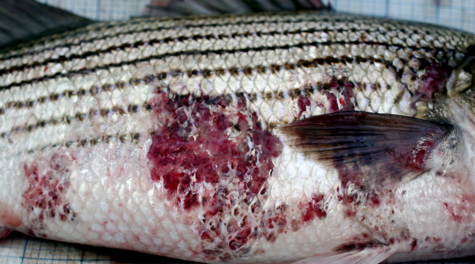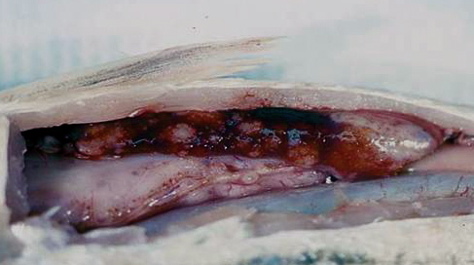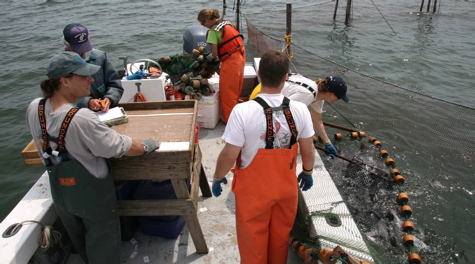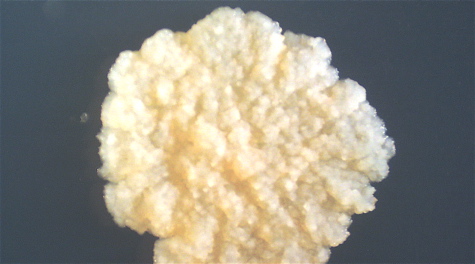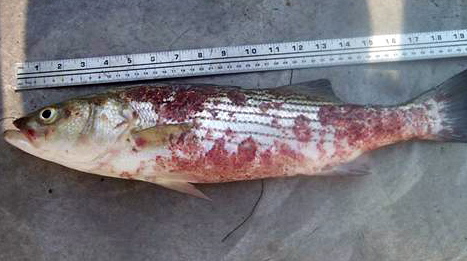Study shows bacterial disease can kill striped bass
A study led by VIMS researchers is the first to demonstrate that striped bass in Chesapeake Bay are succumbing to mycobacteriosis. This chronic bacterial disease, first detected in Bay stripers in 1997, now infects more than half of all striped bass in Bay waters.
The study, which appears in the October 2008 issue of Ecological Applications, was authored by VIMS researchers David Gauthier, Rob Latour, Chris Bonzek, Jim Gartland, and Wolfgang Vogelbein, as well as Erin Burge of Coastal Carolina University and Dennis Heisey of the U.S. Geological Survey’s National Wildlife Center.
Observation of mortality among wild fish is typically limited to acute fish-kill events of schooling species such as menhaden, when large numbers of dead fish float to the surface or wash up on shore.
Detection of mortality from chronic infections is much more difficult, as fish are likely to die by ones or twos through time across a wide area. “Due to the chronic nature of mycobacteriosis in striped bass, the mortality is cryptic,” says lead researcher Gauthier. “That makes it difficult to measure.”
Knowing whether mycobacteriosis ultimately kills Bay stripers is of concern to fisheries managers and anglers all along the Eastern seaboard. Striped bass are one of the region’s most economically and ecologically important finfish, and Chesapeake Bay is the main breeding and nursery ground for this species on the Atlantic coast.
Evidence that mycobacteriois might be killing Bay stripers comes from recent fishery stock assessments, which show an increase in natural, non-fishing mortality among striped bass in Maryland waters since 1999. However, these studies do not differentiate between death due to disease and death due to other factors such as predation or old age.
To test whether mycobacteriosis has contributed to the observed increase in natural mortality, the researchers fed data from a three-year field survey of mycobacteriosis in Chesapeake Bay striped bass into a state-of-the-art demographic model developed by co-author Heisey.
The team conducted the survey work between 2003-2005 in collaboration with the Chesapeake Bay Multispecies Monitoring and Assessment Program (ChesMMAP), an ongoing VIMS study of fish demographics and food-web interactions in the Bay.
“That’s what sets our study apart,” says Vogelbein, a fish pathologist at VIMS. “We were able to provide our model with field data showing the prevalence of infection in different age classes through time.”
For each of the 1,420 striped bass sampled, the researchers determined the fish’s age, sex, and whether it was diseased with mycobacteriosis. They then fed these data into their model. Their findings show that
- A fish infected with mycobacteriosis is only about 70% as likely to survive another year as a non-infected fish.
- Older females are more likely than males to succumb to mycobacteriosis, perhaps due to the energetic demands of spawning and migration.
- Disease-related mortality increases through the summer, possibly due to stress from warm temperatures and low oxygen levels in Chesapeake Bay.
The authors caution that the results of their model rest on several assumptions. One is that an infected fish will remain diseased throughout its life. A second is that the risk of death from mycobacteriosis is independent of age. They write that these assumptions “are reasonable given the current understanding of mycobacterial pathobiology in fishes, but require testing, especially in the context of wild populations. “
“We think our work will inspire tests of these assumptions,” says Gauthier, “and thus help develop more sophisticated models of disease dynamics based on directed field studies and experiments.”


